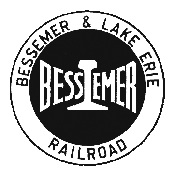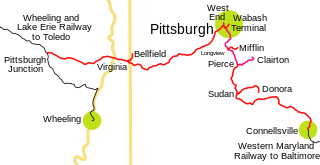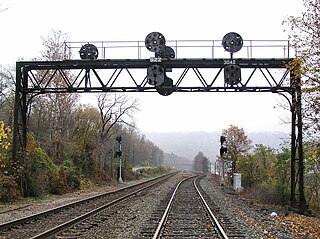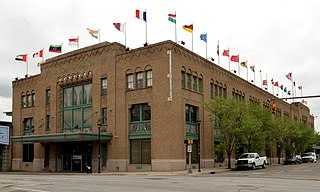
The Delaware, Lackawanna and Western Railroad, also known as the DL&W or Lackawanna Railroad, was a U.S. Class 1 railroad that connected Buffalo, New York, and Hoboken, New Jersey, and by ferry with New York City, a distance of 395 miles (636 km). The railroad was incorporated in Pennsylvania in 1853, and created primarily to provide a means of transport of anthracite coal from the Coal Region in Northeast Pennsylvania to large coal markets in New York City. The railroad gradually expanded both east and west, and eventually linked Buffalo with New York City.
The Little Miami Railroad was a railway of southwestern Ohio, running from the eastern side of Cincinnati to Springfield, Ohio. By merging with the Columbus and Xenia Railroad in 1853, it created the first through-rail route from the important manufacturing city of Cincinnati to the state capital, Columbus. In this period, railroads were important for creating connections between the important waterways of the Great Lakes and the Ohio River, which were major transportation routes for products to other markets.

The Montour Railroad was a short line railroad company operating passenger and freight service in southwestern Pennsylvania. At its height in the 1930s, the railroad served 27 mines transporting nearly seven million tons of coal annually in Allegheny and Washington Counties.

The Bessemer and Lake Erie Railroad was a class II railroad that operates in northwestern Pennsylvania and northeastern Ohio.
The Lake Shore and Michigan Southern Railway, established in 1833, and sometimes referred to as the Lake Shore, was a major part of the New York Central Railroad's Water Level Route from Buffalo, New York, to Chicago, Illinois, primarily along the south shore of Lake Erie and across northern Indiana. The line's trackage remains a major rail transportation corridor used by Amtrak passenger trains and several freight lines; in 1998, its ownership was split at Cleveland, Ohio, between CSX Transportation to the east and Norfolk Southern Railway in the west.

For the purposes of this article, the Jersey City area extends North to Edgewater, South to Bayonne and includes Kearny Junction and Harrison but not Newark. Many routes east of Newark are listed here.
The Pittsburgh and Lake Erie Railroad, also known as the "Little Giant", was formed on May 11, 1875. Company headquarters were located in Pittsburgh, Pennsylvania. The line connected Pittsburgh in the east with Youngstown, Ohio, in the Haselton neighborhood in the west and Connellsville, Pennsylvania, to the east. It did not reach Lake Erie until the formation of Conrail in 1976. The P&LE was known as the "Little Giant" since the tonnage that it moved was out of proportion to its route mileage. While it operated around one tenth of one percent of the nation's railroad miles, it hauled around one percent of its tonnage. This was largely because the P&LE served the steel mills of the greater Pittsburgh area, which consumed and shipped vast amounts of materials. It was a specialized railroad, deriving much of its revenue from coal, coke, iron ore, limestone, and steel. The eventual closure of the steel mills led to the end of the P&LE as an independent line in 1992.

The Pennsylvania Company was a major holding company. It included the Pittsburgh, Fort Wayne and Chicago Railway, the PRR's main route to Chicago. Together with the Pittsburgh, Cincinnati, Chicago and St. Louis Railroad and Vandalia Railroad, the three railroads were branded by the PRR as Pennsylvania Lines West of Pittsburgh. All lines west merged into the Pennsylvania Railroad in 1921.

The Pittsburgh and West Virginia Railway was a railroad in the Pittsburgh, Pennsylvania, and Wheeling, West Virginia, areas. Originally built as the Wabash Pittsburgh Terminal Railway, a Pittsburgh extension of George J. Gould's Wabash Railroad, the venture entered receivership in 1908, and the line was cut loose. An extension completed in 1931 connected it to the Western Maryland Railway at Connellsville, Pennsylvania, forming part of the Alphabet Route, a coalition of independent lines between the Northeastern United States and the Midwest. It was leased by the Norfolk and Western Railway in 1964 in conjunction with the N&W acquiring several other sections of the former Alphabet Route but was leased to the new spinoff Wheeling and Lake Erie Railway in 1990, just months before the N&W was merged into the Norfolk Southern Railway.

The Buffalo Line is a railroad line owned by the Norfolk Southern Railway in the U.S. states of New York and Pennsylvania. The line runs from Buffalo, New York southeast to Rockville, Pennsylvania near Harrisburg, Pennsylvania along a former Pennsylvania Railroad line. Its north end is at Seneca Yard in Buffalo, with no direct access to the Lake Erie district, and its south end is at the Pittsburgh Line at Rockville. The line is operated by the Buffalo and Pittsburgh Railroad between Buffalo and Machias, New York, the Western New York and Pennsylvania Railroad between Machias and Driftwood, Pennsylvania, and the Norfolk Southern Railway between Driftwood and Rockville.

The Schuylkill Branch was a rail line owned and operated by the former Pennsylvania Railroad (PRR) in Pennsylvania. The line ran from the Philadelphia to Harrisburg Main Line at 52nd Street in Philadelphia north via Norristown, Reading, and Pottsville to Delano Junction, about 2.5 mi (4.0 km) northeast of Delano. From Delano Junction, the PRR had trackage rights over the Lehigh Valley Railroad's Hazleton Branch and Tomhicken Branch to Tomhicken, where the PRR's Catawissa Branch began.

The Pennsylvania Canal, sometimes known as the Pennsylvania Canal system, was a complex system of transportation infrastructure improvements, including canals, dams, locks, tow paths, aqueducts, and viaducts. The canal was constructed and assembled over several decades beginning in 1824, the year of the first enabling act and budget items.

Union Station is an Amtrak railroad station and mixed-use commercial building in downtown Erie, Pennsylvania, United States. It is served by the Lake Shore Limited route, which provides daily passenger service between Chicago and New York City or Boston; Erie is the train's only stop in Pennsylvania. The station's ground floor has been redeveloped into commercial spaces, including The Brewerie at Union Station, a brewpub. The building itself is privately owned by the global logistics and freight management company Logistics Plus and serves as its headquarters.

The Western New York and Pennsylvania Railroad is a short-line railroad that operates freight trains in Western New York and Northwest Pennsylvania. The company is controlled by the Livonia, Avon and Lakeville Railroad, with which it does not connect. It started operations in 2001 on the Southern Tier Extension, a former Erie Railroad line between Hornell, New York and Corry, Pennsylvania, owned by the public Chautauqua, Cattaraugus, Allegany and Steuben Southern Tier Extension Railroad Authority (STERA).

The Buffalo, Bradford and Pittsburgh Railroad was formed on February 26, 1859, by the merger of the Buffalo and Pittsburgh Railroad and the Buffalo and Bradford Railroad. The Buffalo, Bradford and Pittsburgh Railroad was leased to the Erie Railroad on January 6, 1866, for period of 499 years. It was most commonly known as the Bradford Branch of the Erie.

The Buffalo and Susquehanna Railroad was a railroad company that formerly operated in western and north central Pennsylvania and western New York. It was created in 1893 by the merger and consolidation of several smaller logging railroads. It operated independently until 1929, when a majority of its capital stock was purchased by the Baltimore and Ohio Railroad. At the same time, the B&O also purchased control of the neighboring Buffalo, Rochester, and Pittsburgh Railway. The Baltimore and Ohio officially took over operations of both roads in 1932.

The Cleveland, Painesville and Ashtabula Railroad (CP&A), also known informally as the Cleveland and Erie Railroad, the Cleveland and Buffalo Railroad, and the Lake Shore Railroad, was a railway which ran from Cleveland, Ohio, to the Ohio-Pennsylvania border. Founded in 1848, the line opened in 1852. The railroad completed the rail link between Buffalo, New York, and Chicago, Illinois.
The Jamestown and Franklin Railroad (J&F) was a shortline railroad which operated in the U.S. states of Ohio and Pennsylvania. Established in 1862, its main line ran from Jamestown, Pennsylvania, to Oil City, Pennsylvania. A branch line connected Jamestown with Ashtabula, Ohio. The railroad leased itself to the Lake Shore and Michigan Southern Railway in 1864 for 20 years. A 1909 consolidation with three other railroads created the Jamestown, Franklin and Clearfield Railroad, and ended the J&F's existence.

The Cleveland and Mahoning Valley Railroad (C&MV) was a shortline railroad operating in the state of Ohio in the United States. Originally known as the Cleveland and Mahoning Railroad (C&M), it was chartered in 1848. Construction of the line began in 1853 and was completed in 1857. After an 1872 merger with two small railroads, the corporate name was changed to "Cleveland and Mahoning Valley Railroad". The railroad leased itself to the Atlantic and Great Western Railway in 1863. The C&MV suffered financial instability, and in 1880 its stock was sold to a company based in London in the United Kingdom. A series of leases and ownership changes left the C&MV in the hands of the Erie Railroad in 1896. The CM&V's corporate identity ended in 1942 after the Erie Railroad completed purchasing the railroad's outstanding stock from the British investors.
The Pennsylvania Petroleum Railroad was a railroad in Pennsylvania originally chartered in 1871, during the Pennsylvania oil rush. Intended to provide an additional outlet from the Pennsylvania oil fields to Erie, Pennsylvania, it graded about ten miles of line in 1872, but was then caught up in the collapse of the Atlantic and Great Western Railroad, which halted the project. The company was foreclosed and reorganized under new names many times, but accomplished relatively little. It laid a short segment of line in 1890 in Titusville, Pennsylvania which was leased to a subsidiary of the New York Central to be used as a siding to a tannery. Further construction took place in 1913 with the idea of opening it as an electric railway to Cambridge Springs, but this, too, was never completed.















